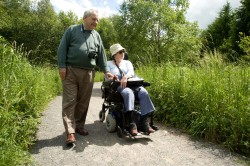Summary
How can the Forestry Commission help disabled people benefit more from its sites?
Summary
In response to the Equality Act 2006 and the amended Disability Discrimination Act 2005, this project reviewed the information held by Forestry Commission staff and services about the needs of different disabled users. Accessibility audits and an assessment of training needs identified the best ways to help staff promote equal access for disabled people.
Key findings
- High level of awareness in the sector concerning the need to promote disabled access
- Awareness of the features of woodlands valued by disabled users, and the need to design access features appropriate to woodland surroundings
- Go beyond physical access (e.g. gates and paths) – incorporate information and facilities which allow disabled users to take part in specific activities
- More advice for staff on how to contact and work with disabled individuals and organisations
- Greater appreciation of physical disability issues – staff need more input on the needs of other disability groups
- Enhance the experience of all users – access provisions should be appropriate for the able-bodied and disabled
- Urban site managers more knowledgeable – less understanding about the recreational requirements and possible options for improving disability in more remote areas
- Main obstacles to providing disabled accessibility – lack of finances and staff resources, liability issues and the physical limitations of the forest site
Publications and presentations
Guidance documents-
Accessibility and Disability: Making Woods More Accessible (PDF-859K).
Funders and Partners
Funded by Forestry Commission Scotland. Commissioned and managed by Forest Research.
The study was undertaken by the OPENspace research centre in Edinburgh.
Status
This project was completed spring 2007.

